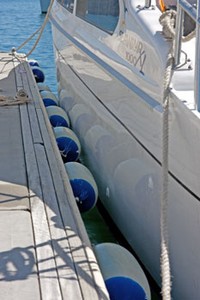Using fenders 101- The smart way
by Smart Boating/Sail-World Cruising on 10 Jan 2011

If there are fenders already on the pontoon, berthing is easy SW
If you want to protect your yacht's topsides from damage, it's important to follow some simple rules and place fenders correctly when you come alongside a wharf or another boat.
Wharves and pontoons:
Sometimes permanent fenders are already on the wharf or pontoon , and this makes life really easy for you as you don't need to use your boat's own fenders. However, sadly, that it often not the case.
So, if there's no protection, you'll need to use 3 or 4 fenders depending on the size of your yacht.
Many people make the mistake of evenly spacing the fenders out along the hull...
... but what you actually want to do is position them to protect the widest part of your yacht.
When using fenders, tie them to the guard rail using a clove hitch. This is important so that you can tie and retie fenders quickly, yet the fender is still secure. See below for how to tie a clove hitch.
Depending on the height of the wharf or pontoon,the smartest thing to do if it's possible (to prevent too much strain on the guard rail) is to tie them to the bottom of a stanchion. This may not be possible, depending on where you need the fender to be the most effective, but it's worth considering each time you dock.
Generally if the bottom of the fender is just above the water line- or just grazing it - you'll be right for most floating pontoons. If it's a fixed wharf that's still a good way to begin, but once the wharf is in good sight, you'll need to estimate the height as you're coming in. If this means you are not ready, request the skipper to go round again to get the fenders in the right position - far better to do this than damaging your yacht's gel coat or paintwork.
Rafting with another boat:
When two monohull yachts of similar size sit side by side the gunwales will touch first if the boats come together.
So this means if one side of your yacht is next to another yacht you'll need to position your fenders high up on the gunwale (no chance of tying the fender to the bottom of the stanchion).
For catmarans the boats will touch each other further down near the middle of each hull so position your fenders lower.
It's also a good idea to keep an extra fender free so that you can protect the boats if they are about to touch somewhere unexpected. NEVER try to use any part of your body to keep yachts apart - you could end up with a serious injury.
If there are fenders on both boats like in these photos there is a chance the fenders can get wrapped round each other as you leave the other boat or a marina berth.
So before you leave the berth bring your own fenders in so there's no risk of a tangle, and when two boats are parting after being rafted together, watch carefully and be prepared to free any tangling.
Fenders are excellent protectors of your boat's topsides, but they don't think for themselves. Watchfulness is the best protection against inadvertent damage.
Tying a Clove Hitch - why and how:
As well as being a great knot when you're using fenders, you can also use a clove hitch secure a line around a rail, post, or other cylindrical structure.
Take a look at the video below if you're not sure how to tie one.
A clove hitch is secure under tension and easy to undo.
It's important you think of it as a temporary knot.
For a secure, more permanent knot, you need to use a bowline
To learn more about http://www.boatshareaustralia.com!Smart_Boating and their boat sharing programs, http://www.boatshareaustralia.com!click_here
...................................
Did you like this story? If you are not a Sail-World subscriber already, did you know that you can keep up with all the news from the world of the cruising sailor with a weekly news hit? It's totally free, as all our income is from the advertisers.
Once you subscribe, all the non-racing news comes to you in one easy to read news magazine, right to your inbox. AND it's up to date, so you don't have to wait for the end of the month to find out what's going on. You can even subscribe a friend. http://www.sail-world.com/Cruising/international/newsletter_subscribe.cfm!Click_here_now!
If you want to link to this article then please use this URL: www.sail-world.com/78989